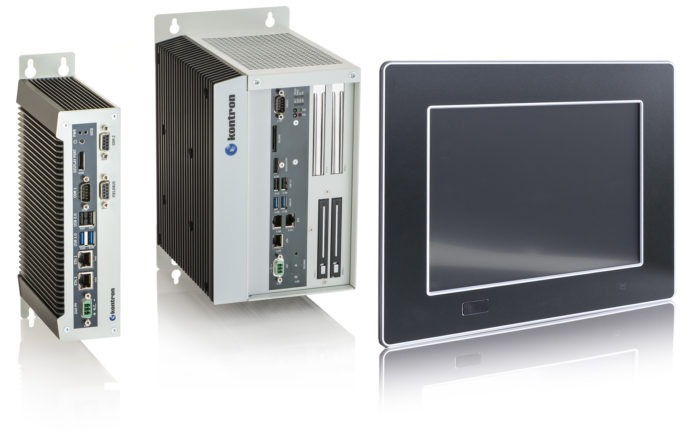By Norbert Hauser
Once powered on, an industry PC keeps on running – day in, day out, either in shifts or 24/7 continuous operation. It works reliably without ever requiring any on-site maintenance. Even infrequent maintenance work such as BIOS battery replacement is no longer necessary.
Maintenance-free industry PCs epitomize the state of ‘zero maintenance’. This is just the type of industry PC which automation engineers, OEMs and industrial users want. The desire for maintenance-free operation is also a question of software for a large number of customers. How can zero on-site maintenance be achieved on operating systems, drivers and applications when even office PCs regularly need new patches? Several options are possible for industrial applications. For example, software can be frozen at a certain status. This is a common practice in certified systems with high security requirements (e. g., power stations).
Software updates minus the on-site expenses
The majority of OEMs do, however, need to update their software on a regular basis, whether in order to provide new functions and features or to optimize program routines. In the past, the preferred procedure was exchanging media cards, such as SD cards. But even if direct access to the systems is possible and an exchange can be performed quickly, it still requires local action and causes unnecessary expense. In the age of the Internet of Things (IoT) and Industry 4.0, even this maintenance service can be omitted. This requires IoT-ready systems integrating the corresponding hardware and software for remote access.
Who benefits from the maintenance-free feature?
The benefits of zero on-site maintenance are realized in large-scale distributed systems. Wind turbine stations, for example, require expensive maintenance due to the cost of travelling to the stations, which, in some cases are off shore and difficult to reach. In these situations, the zero on-site maintenance systems are worth their weight in gold.
On-site maintenance at locations which are extremely difficult to reach or access are not the only scenarios where users profit from zero on-site maintenance systems. Any IPC which does not physically have to be handled for maintenance purposes, cuts costs. The larger and more distributed the installed base is, the greater the effect. With that said, this type of system brings the greatest benefits to the processing, energy, and traffic industries. Additionally, machine and plant builders with large customer bases on a worldwide scale benefit from zero on-site maintenance control and HMI computers.
Avoiding additional indirect costs
Cost-cutting is not just a question of travel expenses, actual maintenance time or spare parts. Advantages result from savings on indirect costs: No spare parts are required for zero maintenance industry PCs. This reduces expenses incurred in the management and storage of spare parts. The costs usually incurred for storing and maintaining traditional wear products with low unit costs weigh heavily on the overall cost of ownership. The beauty of maintenance-free systems is that OEMs can disregard all these factors in favor of a lower Total Cost of Ownership (TCO).
Maintenance-free is equal to reliable
For many users, however, the systems’ reliability – rather than the TCO – has the highest priority. This is especially true wherever production failure can lead to significant losses. Even a few minutes delay in production caused by a failure in an industry PC can incur considerably higher costs than its actual purchase price. This is where the built-in, high reliability of maintenance-free systems offers protection. Maintenance-free systems also have a higher MTBF because wear parts (e.g., batteries, fans, rotating storage) are not deployed.
The automotive industry has proven that maintenance-free systems actually increase system reliability. In recent years the automotive industry has markedly improved the service intervals of their vehicles. This is both a strong selling point for customers, as well as a benefit to them as less maintenance decreases the potential for errors to occur when maintenance is being carried out. Although cars are more complex than IPCs, the human factor in maintenance cannot be completely ruled out when IPCs are being serviced.
How to achieve the state of ‘maintenance-free’?
To achieve a zero on-site maintenance operation, IPCs have to meet several conditions. The most important design element is no rotating components, such as fans and HDDs, to be integrated. These parts can wear and need exchanging on a regular basis. Additionally, they are vulnerable to shock and vibration. In order for industry PCs to be maintenance-free and robust, they have to be constructed without fans and equipped with flash memory, which works purely electronically and is thus not susceptible to mechanical stress.
The second critical design element is basic energy-efficient technology, which offers a high performance-per-watt ratio with low waste heat. Low-power CPUs, such as the Intel® Atom™ processors, are ideally suited and are also available as energy-efficient System on Chips. High-performance systems in the compact book-size format are also possible with this latest technology. The 4th generation new Intel® Core™ processors power consumption can be reduced so that fanless system designs are even possible for high-end class industrial computers.
The third key design element lies in the details. The BIOS or the EFI memory power supply to the internal system clock can present a pitfall. Internal system clocks require an internal energy source to supply them with electricity if the IPC is switched off. If this power source is turned off, the settings and the system clock will be reset, resulting in the system being unable to restart properly without user input. The required user input can be very complex if the systems are being run without keyboard and/or monitor or the ports are covered. Fixing these ’minor’ things can easily clock up a maintenance hour. To avoid this, traditional button cell batteries, which have to be exchanged every two or three years, are not integrated on maintenance-free systems. Instead wear-free double layer capacitors, so-called gold caps, are used.
Other, inevident details, such as a completely sealed chassis and intelligently designed power supplies, improve the reliability of the hardware. Optimized power supplies with high support time can prevent a system reset by bridging a short power failure in the supply voltage. Should a power failure occur for a longer period of time, the optimized power supplies enable the system to boot automatically; operation can continue normally without any user intervention.
But a system does not qualify as maintenance-free if remote access is not possible. With remote access important functional data such as temperatures of all the relevant components can be read or remote configurations can be made. In the majority of cases, however, a network connection alone does not suffice. The systems have to support remote management functions and provide the corresponding software tools.
There are numerous hardware choices to consider, for example, Intel®’s Advanced Management Technology (Intel® AMT) which is part of Intel®’s VPro Technology, can be used. The software to enable remote connection is a Kontron standard product. The Kontron Embedded API (KEAPI) including matching Kontron Remote-Services (KRS) for many of its systems allows developers to,, reliably and securely, address numerous system functions remotely via an embedded web server. Including, for example, the monitoring of system parameters as well as the active operation of specific embedded features, like I²C, backlight control and watchdog configuration. Even fail-safe BIOS updates can be carried out in this manner. An additional security layer protects against unauthorized access. If OEMs use the KEAPI and KRS infrastructure, they can implement a uniform remote access and management solution for a variety of platforms. They can offer their customers a profit-enhancing and long-lasting value-added service at lower development costs. Kontron will continue to expand this software support. An important issue for users to be aware of is that KRS is not a closed system. It is, more than anything, a feature which Kontron offers that is platform-independent and works with different operating systems. For M2M applications, complete development systems including cloud-connectivity are available which users can use to develop their networked systems.
 Kontron’s IPCs KBox-A-101 and KBox C-101 along with the Panel-PC Micro Client 3/3W with a multi-touch display
Kontron’s IPCs KBox-A-101 and KBox C-101 along with the Panel-PC Micro Client 3/3W with a multi-touch display
The first three maintenance-free systems from Kontron
The first products that Kontron has developed for zero on-site maintenance system installations of OEMs and automation providers, are the Kontron IPCs KBox-A-101 and KBox C-101 along with the Panel-PC Micro Client 3/3W with a multi-touch display. These are all fanless and equipped with flash memory and gold caps. With an MTBF of between 40,000 and 70,000 hours, depending on the system and configuration, they deliver maximum reliability. This corresponds to 24/7 operation over a period of up to eight years or in one-shift operation of up to 24 years. So, today, from a technical perspective, they will require no maintenance whatsoever during their operating time.
If systems are designed to be completely maintenance-free, not a single rupee has to be invested in maintenance. Reliable operation is assured and this results in the high availability of the machines and equipment. ‘Zero on-site maintenance’ is a feature with which OEMs and automation suppliers can differentiate their offer towards end-users who will appreciate the added value. Of course, in order to ensure the feasibility, the application-specific conditions have to fit the bill. The write cycles of the application, for example, must not exceed the write cycles of the flash memory during the MTBF. Furthermore, remote system access has to be executed in such a way that a software update will never suddenly require a system reboot on-site. So, let’s get to work!
Norbert Hauser is the Head of Business Line – Industrial Automation at Kontron.













